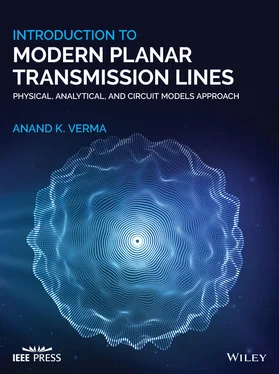The author expresses his unbounded love and regards to his parents – Late Sh. A.P. Verma and Late Tara Devi, Uncle Late Sh. Hira Prasad, to grandmother Late Radhika Devi, and Uncle and Life‐guide Sh. Girija Pd. Srivastava. The author also is grateful to his teacher Prof. M.K.P. Mishra for excellent teaching of Circuit Theory in unique style, and for providing support in many ways. The author is thankful to his family members for their encouragement and support. Finally, I wish to express my heartfelt thanks and deepest appreciation to my wife, Kamini. The smiling faces of my grandchildren, Naina, Tinu, and Nupur have always kept me going on with the tiring work of book writing.
Anand K. Verma
New Delhi, Sydney
Anand K. Verma, PhD, is an adjunct professor in the School of Engineering, Macquarie University, Sydney, Australia. Formerly, he was professor and head, Department of Electronic Science, South Campus, University of Delhi, New Delhi, India. He has been a visiting professor at Otto van Guericke University, Magdeburg, Germany (2002–2003), and a Tan Chin Tuan Scholar (2001) at Nanyang Technological University, Singapore. He holds a German patent on a microstrip antenna. He has introduced the concept and design method of surface-mounted compact horn antenna used for high gain, wideband, and ultra‐wideband quasi-planar antenna applicable to both linear and circular polarization. He has organized and attended many international symposia and workshops. He has conducted short-term courses and delivered invited lectures at the research institutes in India and several countries. He was also chairman of the TPC, APMC-2004, New Delhi, India. Professor Verma has published over 250 papers in international journals and the proceedings of international and national symposia. He has introduced the concept of single layer reduction (SLR) formulation for the CAD-oriented modeling of multilayer planar lines.
1 Overview of Transmission Lines: ( Historical Perspective, Overview of Present Book )
Introduction
The transmission line is at the core of the communication technology system. It forms a medium for signal transmission, and also helps to develop high‐frequency passive components and circuit blocks. Historically, both experimental investigations and analytical theories have played significant roles in the growth of transmission line technology. Each type of distinct line structure is responsible for the development of distinct communication technology. The single‐wire transmission line with the Earth as a return conductor is responsible for the operation of Telegraphy. It evolved into the coaxial cable that made the Transatlantic Telegraphy possible. The two‐wire open line became a medium for the Telephonic transmission . These two line structures are behind the development of the monopole and dipole antenna that made possible the growth of the high‐frequency communication using the medium wave (MW), short wave (SW), very high‐frequency (VHF), and ultra‐high frequency (UHF) bands. The microwave and mm‐wave transmission systems are developed mostly around the metallic waveguides, and subsequently also using the nonmetallic dielectric waveguides. Finally, it has resulted in modern optical fiber technology. The planar transmission lines are behind the modern advanced microwave communication components and systems.
The present chapter provides a very brief historical overview of the classical and modern planar transmission lines. The chapter presents a historical survey of the development of the electromagnetic (EM) theory also. Next, a brief overview of the organization of the book is discussed.
To present a survey of the developments of the classical EM‐theory.
To present brief historical notes on the classical transmission lines and development of transmission line theory.
To present brief historical notes on planar transmission lines.
To present an overview of the contents of the book.
1.1 Overview of the Classical Transmission Lines
The classical transmission lines such as a single‐wire line with the earth as a return conductor, coaxial cable, two‐wire line, multi‐conductor lines, and waveguides are reviewed very briefly in this section. The historical development of the Telegrapher's Equations is also presented. The developments of the theoretical concepts of EM-theory are reviewed below. The data related to the review of the EM‐theory and transmission lines are collected from the published books [B.1–B.7] and journal articles referred at the end of the chapter.
The telegraph is the first coded point‐to‐point electrical communication system. As early as 1747, William Watson showed the possibility of transmitting an electrical current on a wire using the earth as a return conductor. Thus, overhead single‐wire with the earth as a return conductor is the first transmission line. It is to be noted that even the voltaic pile , i.e. the chemical battery of Volta was nonexistent at that time. The Leiden jar, a capacitor to store the static electrical charges, was invented just two years before in 1745. However, much earlier in the year 1663, Otto Von Guericke studied the phenomenon of static electricity and designed a machine to produce it. Thus, the charged Leiden jar became a source of electricity, and single‐wire transmission was the communication medium. These were two important ingredients to establish the telegraph link. The third ingredient of telegraphy, the electroscope , invented by William Gilbert around 1600, acted as the receiver for the coded signals. It is interesting to note that the telegraph was conceived without any theoretical investigations on electricity. Even Coulomb's law was discovered later in 1785. However, the proper telegraphy could be developed only after the invention of voltaic pile, i.e. a chemical battery by Volta in 1799. Further development of the telegraph has an involved history. In 1837, Morse patented his telegraph in the United States, and on January 6, 1838, the first telegram was sent over 3 km distance. Cooke commercialized the telegraph in England and established the 21 km link on April 9, 1839. Thus, an era of electrical communication heralded. In 1844, long‐distance Morse's telegraph between Washington, DC, and Baltimore, Maryland was established. Before further reviewing the growth of the classical transmission lines, it is useful to have a quick look at the theoretical developments related to electricity [B.5].
1.1.2 Development of Theoretical Concepts in EM‐Theory
The ancients unfolded our story of Electromagnetism through careful observations of the phenomena of static electricity and natural magnetism. The developments of basic concepts, analytical modeling, and theoretical formulations used in the EM‐Theory are emphasized in the review. The theoretical concepts of the electric and magnetic fields followed the mathematical models developed for the gravitational force by Newton in 1687, and subsequently refined by other investigators. The development of the theoretical models of transmission lines inherited the modeling process, and mathematical method of Fourier developed for the transmission of heat in a rod.
Electrostatics and Scalar Potential
Newton published his theory of gravitation in his monograph Philosophiae Naturalis Principia Mathematica . Newton viewed the gravitational interaction between two masses through force . The effect of static electricity was known for a long time, at least since 600 BC. However, only in 1600, Gilbert carried out systematic studies of both magnetism and static electricity. The static electricity was generated by the rubbing of two specific objects. He suggested the word electricus for electricity, and the English word “ electricity ” was suggested by Thomas Browne in 1646. Gilbert also suggested that the electrical effect is due to the flow of a small stream of weightless particles called effluvium . This concept helped the formulation of one‐ and two‐fluid model of electricity. He also invented the first electrical measuring instrument, the electroscope , which helped further experimental investigations on electricity.
Читать дальше












